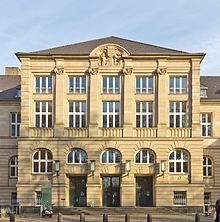Maria Mies
Assigned to a school in Pune, India, she discovered that while her male students took German courses to further their education, women for the most part took her classes to avoid marriage.
Returning to study at the University of Cologne, she prepared her dissertation about contradictions of social expectations for women in India in 1971, earning her PhD the following year.
Returning to Germany and the University of Applied Sciences in 1981, Mies became involved in the ecofeminist movement and in activism against genetic engineering and reproductive technology.
Soon after her return to Germany her mother made a full recovery,[1] and Mies enrolled at the University of Cologne to study sociology under René König.
[2] She participated in the Politische Nachtgebete [de] (political night-prayers), organised by Dorothee Sölle, which were aimed at questioning the status of women in the church.
To enable her students to complete the practical requirements, Mies made contact with local feminist groups to develop joint projects they could carry out.
[1] The administration decided not to renew the "Women and Development" programme for the next semester but Mies and her students successfully protested and the course continued to be offered.
[1] Because no textbooks at that time existed on the history of women's movements, particularly for the Global South, Mies and Kumari Jayawardena, a political scientist at the University of Colombo, wrote a series of texts for their students to use.
Launching an international research project, she worked with scholars Mia Berden, Rhoda Reddock, and Saskia Wieringa to create a historiography of women's movements for Africa, Asia, the Caribbean, and Latin America with help from academics and activists from those countries.
She became involved in the ecofeminist movement, as well as in activism against genetic engineering and reproductive technology, which she saw as an expropriation of a woman's right to give birth and a commercialization of human production.
[1][15]: 97 Mies also pointed out that to exercise decisions about their bodies, women are limited by systems designed, controlled, and administered by health providers and government officials.
Her pacifism was reinforced by her opposition to the idea put forth by Alice Schwarzer that women could gain emancipation if they had the same violent means which were available to men.
[19]: 2 The anthropologist Danielle Léveillé characterised Mies's works as both "masterful" and "astonishing" in that she was able to link variables from the anti-colonial, anti-racist, ecology, feminist, and non-violence movements to critique policies that established power relationships in society.
[18]: 149 Political scientist Elisabeth Prügl [wikidata] pointed to Mies's connection of the threads in society that united women, colonised people, and nature as being free for exploitation.
In the work, she found that socialist development had created similar social structures exploiting women and argued for creation of a utopian feminist society.
She theorised that if consumers in overdeveloped places fulfilled their needs to sustain life from producers in underdeveloped countries, it would give worldwide relief from exploitation.
[18]: 150–151 Léveillé noted that while such a plan might work, its drawback was that it devalued things like music, flowers, and art, which while not essential or necessary to support human life provided therapeutic benefits.
[18]: 151 Picking up themes of domination from Patriarchy and Accumulation, Mies's 1988 book Women: The Last Colony, written with social scientists Veronika Bennholdt-Thomsen and Claudia von Werlhof, brought colonised people into the analysis.
[21]: 388 Departing from a strict Marxist feminist argument, the central theme of the work was that the exploitation and oppression of women and colonised people were not secondary results caused by capitalism, but fundamental to creating the mechanisms of global production.
[21]: 388–389 [22]: 50 Université de Montréal anthropology professor, Deirdre Meintel [wikidata], noted that Mies argued that labour exploitation was a primary factor in developing both social classes and economic divisions.
[21]: 390 Ecofeminism (1993), written by Mies and scholar Vandana Shiva used a Marxist approach to evaluate climate change, loss of diversity, multi-systemic failures, and resistance.
According to the environmental scholar Catriona Sandilands, unlike other ecofeminist works the book demonstrated that despite geographical differences and socio-economic variances "women's lives and bodies are being colonised" through capitalist mechanisms.
[23]: 171–172 Evaluating the links between technology, science, and cultural development, scholars Jimena Andrieu and María Julia Eliosoff Ferrero, said that Mies and Shiva pointed out that globalisation led to a crisis which reduced human freedoms by commodifying and privatising everything to increase production and profits.
[23]: 173 Mies and Shiva argued that by placing nurturing of life and health as the focal point of economics, a balance between society, the economy, and the ecosystem would be restored.
Andrieu and Eliosoff disagreed with the theory, saying that with large sectors of the population unemployed and living in poverty in the southern hemisphere, the turn toward subsistence and producing only goods that sustain life was questionable.
Klein said that Mies's youth in a self-sufficient farming village gave her the practical skills to meet life's struggles and shaped her future works on subsistence theory.
She called the autobiography "an important piece of contemporary and women's history", because it recalled how feminism – and the fight against discrimination, exploitation, and violence – had changed and grown over the period of Mies's life.




